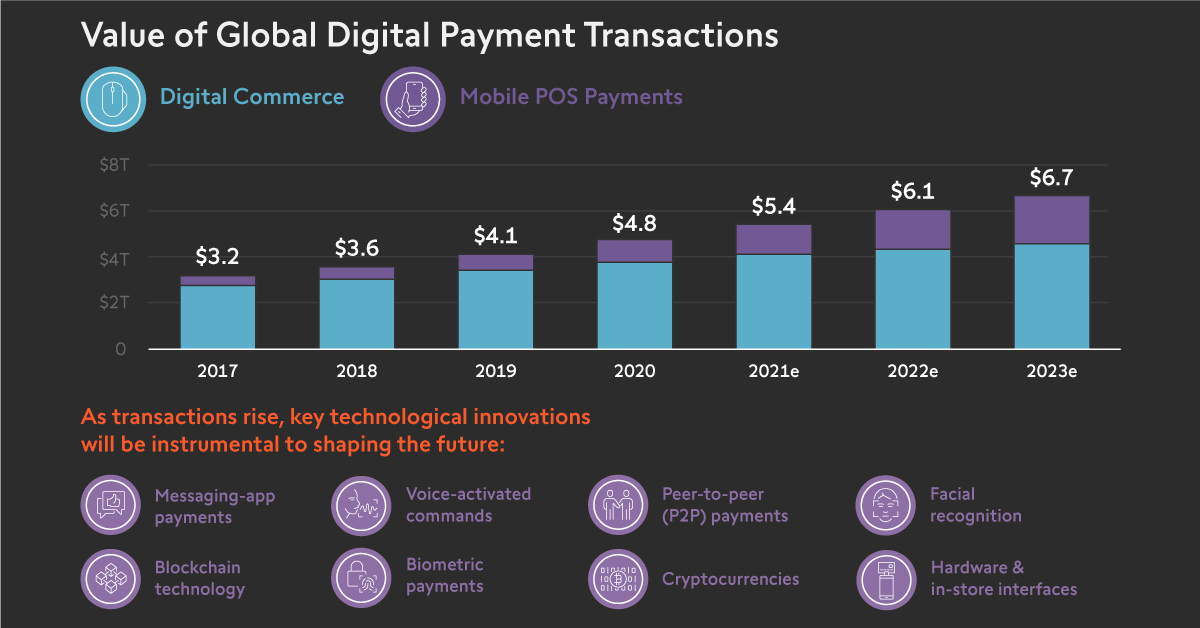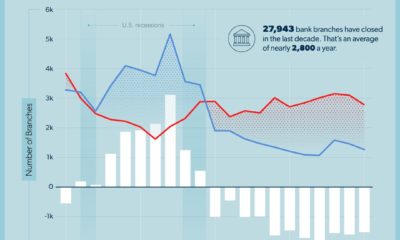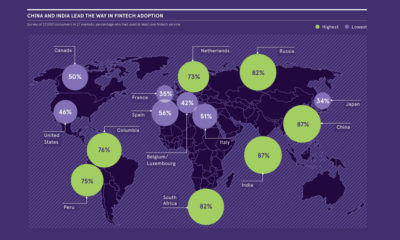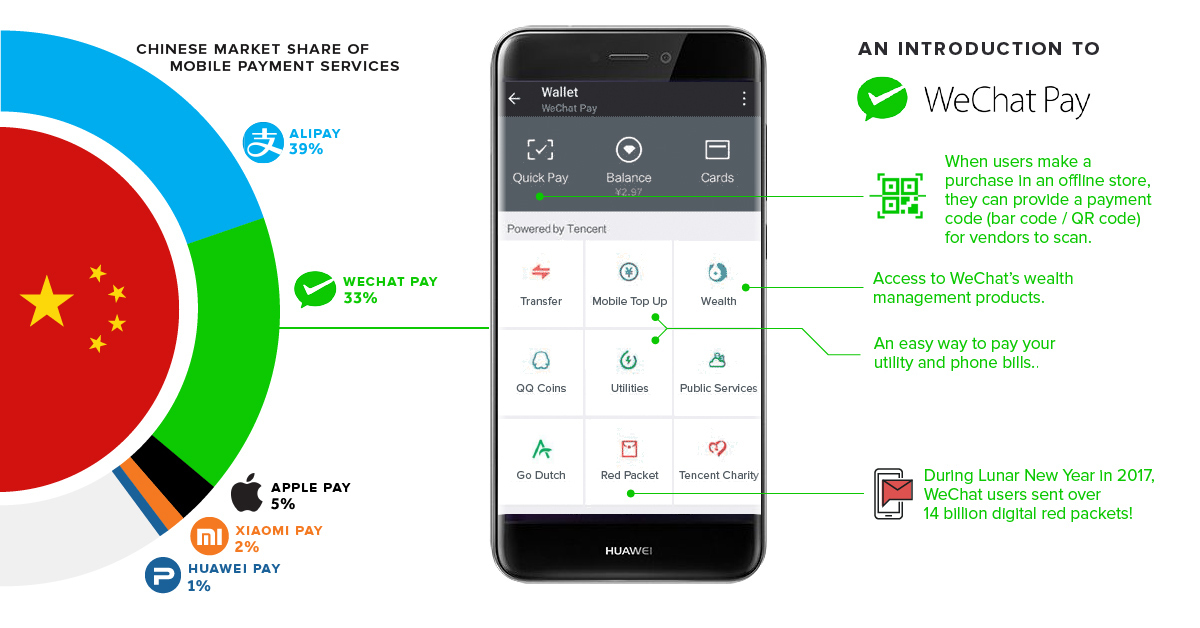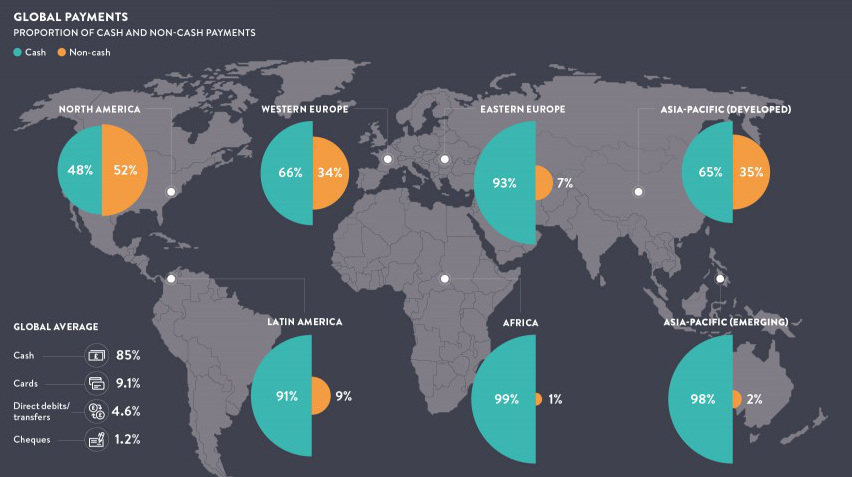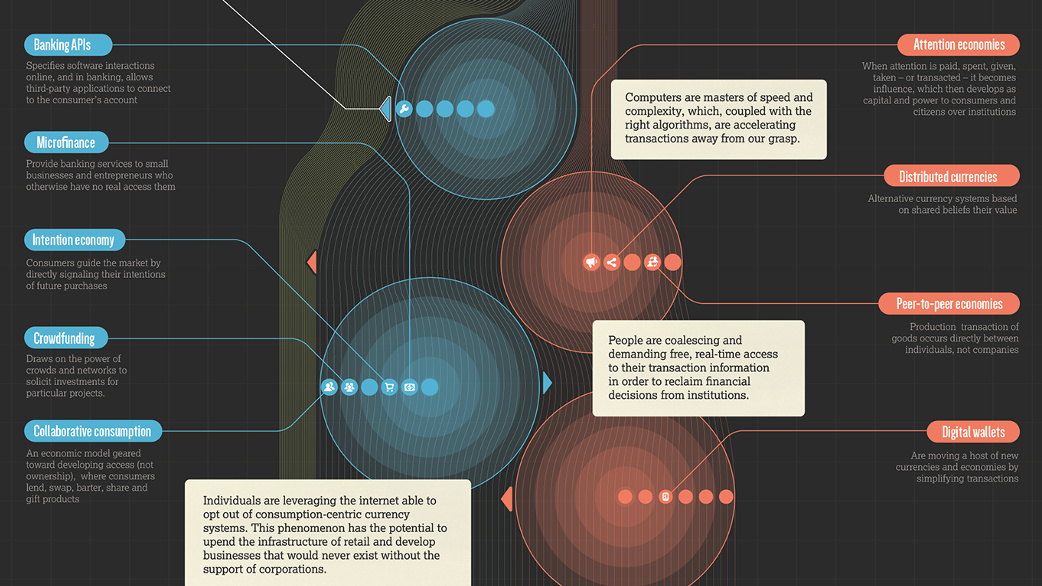Technology
Visualizing the Rise of Digital Payment Adoption

Digital Payments: The Evolution of Currency
Over the last decade, the digital payments landscape has undergone a structural shift.
Consumer behaviors are changing—moving towards contactless and cashless transactions. Meanwhile, as the magnitude of COVID-19 grows, these trends have only accelerated.
Today’s infographic navigates the digital payments ecosystem, exploring its history and innovative technologies, and how it continues to grow as a solution of choice for trillions of dollars of transactions each year.
Digital Payments Timeline
The origins of digital payments began over 25 years ago with then 21 year-old entrepreneur Dan Kohn in Nashua, New Hampshire, who sold a CD over the internet via credit card payment.
- 1994: First online purchase is made
A CD of Sting’s Ten Summoner’s Tales is sold for $12.48 on NetMarket. - 1997: First mobile payments and first contactless payments
Coca-Cola installs two vending machines in Helsinki that accept payment by text message. - 1999: Paypal launches electronic money transfer service
Early on, PayPal’s user base grew nearly 10% daily. Tesla CEO Elon Musk and venture capitalist Peter Thiel were among its co-founders. - 2003: Alibaba launches Alipay in China
Today, the mobile payment platform has witnessed stunning growth — leveraging digital wallets accepted by merchants in over 50 countries and regions. - 2007: M-PESA creates the first payments system for mobile phones
Kenya-based M-PESA launched its mobile banking and microfinancing service. Today, it has over 37 million active users on its platform across Africa. - 2009: Bitcoin enables secure, untraceable payments
Satoshi Nakamoto develops the first decentralized payment network in the world. - 2013: WeChat Pay is rolled into the popular messaging platform
By 2018, it surpasses 800 million monthly active users. - 2014: Apple Pay launches
By 2023, over $2 trillion of mobile payment transactions could be authenticated by biometric technology.
As technological advances continue to unfold, advances in digital payment technologies are creating ripple effects globally.
Geographical Differences in Adoption
Unsurprisingly, the sheer volume of digital payments has continued to grow at a double-digit pace, now surpassing the $4.1 trillion mark.
How do cashless payments break down across different countries?
| Country | Daily Average Volume of Cashless Payments | Average Annual Cashless Payments Per Person |
|---|---|---|
| Singapore | 13M | 831 |
| South Korea | 77M | 547 |
| Sweden | 15M | 529 |
| Netherlands | 24M | 505 |
| U.S. | 444M | 495 |
| UK | 82M | 448 |
| Canada | 40M | 393 |
| Belgium | 12M | 372 |
| France | 64M | 363 |
| Switzerland | 7M | 299 |
| Germany | 61M | 269 |
| Russia | 95M | 237 |
| Spain | 24M | 185 |
| Brazil | 95M | 166 |
| China | 543M | 142 |
| Italy | 18M | 111 |
| Turkey | 17M | 77 |
| Indonesia | 30M | 42 |
| Mexico | 14M | 40 |
| India | 67M | 18 |
Source: BIS
Singapore has the highest number of cashless payments per individual, averaging 831 cashless payments annually. The country’s robust e-commerce market is supported by high-speed, reliable internet and a young, tech-savvy population.
With e-commerce spending accounting for about 6% of South Korea’s national GDP, it is another leading purveyor of a cashless society. Meanwhile, Sweden is projected to become a cashless nation as early as 2023.
Pivotal factors—including core infrastructure, consumer behavior and rising revenues—provide a glimpse into the rapidly changing payment horizon.
The Future of Digital Payments
As transactions rise, a number of other technological innovations could be instrumental to shaping the evolution of the digital payments industry:
- Messaging-app payments
Facebook Messenger, WhatsApp, and WeChat can leverage the reach of billions of users. - Voice-activated commands
Paying for gas, groceries, or retail via voice could soar. - Peer-to-peer (P2P) payments
Bank of America and Visa are investing heavily into P2P partnerships. - Cryptocurrencies
Over one million transactions take place daily on average. - Biometric payments
Smartphone biometric security features could spur traction across digital payments. - Facial recognition
May soon replace QR codes across retail, transit, and airports in China. - Crypto wallet adoption
Blockchain wallet users are predicted to soar to 200 million by 2030. - Hardware & in-store interfaces
Square, Stripe, and Clover are driving new mobile processing integrations.
The $4.1T digital payments ecosystem is facing a notable transition, catalyzed by a wave of global advancements and disruption. As the industry continues to widen its reach, consumers and investors alike can benefit from the shift towards a cashless economy.
Technology
Visualizing AI Patents by Country
See which countries have been granted the most AI patents each year, from 2012 to 2022.

Visualizing AI Patents by Country
This was originally posted on our Voronoi app. Download the app for free on iOS or Android and discover incredible data-driven charts from a variety of trusted sources.
This infographic shows the number of AI-related patents granted each year from 2010 to 2022 (latest data available). These figures come from the Center for Security and Emerging Technology (CSET), accessed via Stanford University’s 2024 AI Index Report.
From this data, we can see that China first overtook the U.S. in 2013. Since then, the country has seen enormous growth in the number of AI patents granted each year.
| Year | China | EU and UK | U.S. | RoW | Global Total |
|---|---|---|---|---|---|
| 2010 | 307 | 137 | 984 | 571 | 1,999 |
| 2011 | 516 | 129 | 980 | 581 | 2,206 |
| 2012 | 926 | 112 | 950 | 660 | 2,648 |
| 2013 | 1,035 | 91 | 970 | 627 | 2,723 |
| 2014 | 1,278 | 97 | 1,078 | 667 | 3,120 |
| 2015 | 1,721 | 110 | 1,135 | 539 | 3,505 |
| 2016 | 1,621 | 128 | 1,298 | 714 | 3,761 |
| 2017 | 2,428 | 144 | 1,489 | 1,075 | 5,136 |
| 2018 | 4,741 | 155 | 1,674 | 1,574 | 8,144 |
| 2019 | 9,530 | 322 | 3,211 | 2,720 | 15,783 |
| 2020 | 13,071 | 406 | 5,441 | 4,455 | 23,373 |
| 2021 | 21,907 | 623 | 8,219 | 7,519 | 38,268 |
| 2022 | 35,315 | 1,173 | 12,077 | 13,699 | 62,264 |
In 2022, China was granted more patents than every other country combined.
While this suggests that the country is very active in researching the field of artificial intelligence, it doesn’t necessarily mean that China is the farthest in terms of capability.
Key Facts About AI Patents
According to CSET, AI patents relate to mathematical relationships and algorithms, which are considered abstract ideas under patent law. They can also have different meaning, depending on where they are filed.
In the U.S., AI patenting is concentrated amongst large companies including IBM, Microsoft, and Google. On the other hand, AI patenting in China is more distributed across government organizations, universities, and tech firms (e.g. Tencent).
In terms of focus area, China’s patents are typically related to computer vision, a field of AI that enables computers and systems to interpret visual data and inputs. Meanwhile America’s efforts are more evenly distributed across research fields.
Learn More About AI From Visual Capitalist
If you want to see more data visualizations on artificial intelligence, check out this graphic that shows which job departments will be impacted by AI the most.
-

 Markets1 week ago
Markets1 week agoU.S. Debt Interest Payments Reach $1 Trillion
-

 Business2 weeks ago
Business2 weeks agoCharted: Big Four Market Share by S&P 500 Audits
-

 Real Estate2 weeks ago
Real Estate2 weeks agoRanked: The Most Valuable Housing Markets in America
-

 Money2 weeks ago
Money2 weeks agoWhich States Have the Highest Minimum Wage in America?
-

 AI2 weeks ago
AI2 weeks agoRanked: Semiconductor Companies by Industry Revenue Share
-

 Markets2 weeks ago
Markets2 weeks agoRanked: The World’s Top Flight Routes, by Revenue
-

 Demographics2 weeks ago
Demographics2 weeks agoPopulation Projections: The World’s 6 Largest Countries in 2075
-

 Markets2 weeks ago
Markets2 weeks agoThe Top 10 States by Real GDP Growth in 2023

